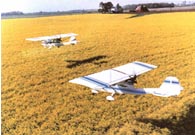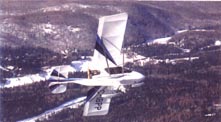|
The decision of which aircraft to build is often difficult and agonizing. New kits come and go every year. All manufacturers publish performance figures, and while these are helpful in comparing aircraft, there are other factors that are less easily obtained but are often more important.
The reputation of the manufacturer, Quad City Ultralight, is one of the most respected in the industry and is the original designer and manufacturer. The Challenger has perhaps the best performance and safety record in the industry, and has the track record to prove it.
Put this together with the experience and customer support of Adventure Aviation and our many happy builders will tell you that this is a combination that will give you a fun building project and many years of enjoyable flying.
1. Proven Design
2. Customer Support
3. Factory Built Airframe
4. Versatility
5. Visibility
6. Performance
7. Low Cost
8. Challengers Owners Association
9. Low Restrictions
10. Year Around Use
1. Proven Design
The basic Challenger design has been in production since 1982 with over 2200 Challengers flying. Over the years, there have been continuous subtle safety and performance improvements and the Challenger has one of the very best safety records in the industry.
When you build a Challenger kit, you build an aircraft that has a long, positive track record. It is a kit produced by one of the most respected of the industry leaders, Quad City Ultralight Aircraft Corp.
2. Customer Support
The Challenger has a very supportive manufacturer, and Adventure Aviation is a full time, full service dealer. Many manufacturers only sell factory or distributor direct and this deprives the purchaser of dealer support.
Adventure Aviation backs our customers with hands on building support, construction and air worthiness inspections, initial flight testing, and flight training. We can advise and assist you with all phases of constructing your aircraft and assist you with all required registration and inspections.
Adventure Aviation has several years full time experience with Challenger and sport aviation. That knowledge is available to you at your shop or mine, via e-mial or telephone, 14 hours a day, 7 days a week.
No special tools or welding are required to build the Challenger, just common hand tools. Basically, a hand or air riviter, 1/4 inch drill, and an air compressor with paint spray gun if you intend to do you own painting. No special shop skills are needed to turn out a beautiful aircraft. With the advice and support of Adventure Aviation, even a first time amateur can do a high quality job with even the most intimidating aspects of kit construction, such as fabric covering and painting.
3. Factory Built Airframe
The Challenger fuselage, wing frames, and tail surface frames are built at the factory. All controls are installed. All critical drilling, such as wing and strut attach bracket holes are done in jigs at the factory. This means that the builder does not have to do any critical measuring or mathematical calculations to determine such things as dihedral or bolt angels. This attention to detail relieves the builder of any worries over building an aircraft that is "out of rig" or that will have any unexpected or difficult flight characteristics. |
|
 |
The completeness of the Challenger kit will ensure a fun project with a low build time. This level of detail and ease of building are major reasons why Challenger has an almost 100% completion rate.
The Challenger fuselage, wing frames, and tail surface frames are built at the factory. All controls are installed. All critical drilling, such as wing and strut attach bracket holes are done in jigs at the factory. This means that the builder does not have to do any critical measuring or mathematical calculations to determine such things as dihedral or bolt angels. This attention to detail relieves the builder of any worries over building an aircraft that is "out of rig" or that will have any unexpected or difficult flight characteristics.
The completeness of the Challenger kit will ensure a fun project with a low build time. This level of detail and ease of building are major reasons why Challenger has an almost 100% completion rate.
4. Versatility
The Challenger is an aircraft that is equally at home with flying low and slow, seeing the sights up close, or traveling long distances loaded with camping gear. It will do this just as happily on wheels, skis, or floats.
On wheels, the Challenger has excellent performance and is also a very capable motor glider. Circling silently with the engine off while climbing in a summer thermal is a thrill few aircraft can offer.
On skis, the Challenger opens up one of the best flying seasons, when most planes are in hibernation. The Challenger's engine and prop drive require no preheating and thrive on cold winter air, the same cold, dense air that gives the Challenger its best performance of the year. Skis mean you can land in more places then you ever imagined and with Adventure Aviation's heater, you will fly in comfort in your enclosed cabin.
On Puddlejumper Amphibious Floats the Challenger is a very capable floatplane, while retaining both its low and slow and cross country capabilities. Hug the shoreline for miles at 5 feet above the water or cruise at 70 MPH with pilot and passenger. Get into and out of those small lakes that even a Super Cub would not consider. Cruise comfortably over land or water, the Puddlejumper Amphibious Floats allow you to land easily on water or runway.
Add to all this, the ease of switching between wheels, skis, and floats, the Challenger is indeed a very versatile aircraft.
5. Visibility
In a conventional aircraft your view ahead is blocked by the instrument panel and engine. In a low wing, the wings block the view below. In a high wing, the wing blocks the view above and into the turn. |
|
 |
In the Challenger with its tandem seat, there is no obstruction to your side and the view over the nose is excellent. The pilot sits in front of the high wing of a Challenger and can see where he is going in a turn.
With doors on or off, the visibility from a Challenger is spectacular, making it a wonderful aircraft for sightseeing or photography.
6. Performance
In a conventional aircraft your view ahead is blocked by the instrument panel and engine. In a low wing, the wings block the view below. In a high wing, the wing blocks the view above and into the turn.
The big, highlift wing and light weight of the Challenger give it great lifting ability, slow speed capability, and STOL (short take off and landing) performance. Its strong Rotax engine and new prop drive give it a top speed of over 90 MPH. This excellent performance at both ends of the speed range give the Challenger a better speed range then most recreational aircraft and far exceeds the Cessna and Piper. |
|
 |
The Challenger can handle a direct crosswind of 20 MPH on landing and the clip wing, flown by an experienced pilot, can handle up to a 30 MPH crosswind.
Some kitplanes can match the Challenger in 1 or 2 performance parameters, but none combine the whole performance range into one aircraft as well as the Challenger.
7. Low Cost
The basic Challenger II (our most popular) can be had for a little over $8000.00. Our optional large power package with the 503 Rotax (our most popular) can be had for a little over $4000.00. Add paint, instruments, and a few options and have a brand new airplane for the price of an economy automobile. Try to find a new general aviation aircraft with comparable performance at several times the price.
The Challenger Rotax engine was designed to run on auto gas. Combined with the low price and low maintenance, the Challenger's operating costs will be only a fraction of the hourly cost of a general aviation aircraft.
8. Challenger Owners Association
The Challenger Aircraft is supported by an independent owners association, The International Challenger Owners Association with hundreds of members world wide.
The Association has many fly-ins, especially in Canada, and publishes a quarterly newsletter. All the issues contain much useful information such as building tips, what other owners are doing, any updates or bulletins from the factory, fun flying stories, and will help you keep abreast of what is happening in the world of Challenger.
9. Low Restrictions
In the U.S. the single place aircraft can be flown as a F. A. R. part. 103 ultralight with extremely few restrictions. All the Challengers can be registered in the U.S. as "experimental" and can be flown with a private pilots certificate or an easily and inexpensively obtained recreational pilots certificate.
In Canada, the Challenger is easily registered as an Ultralight and can be flown with a pilots license or an easily obtainable recreational license.
10. Year Around Use
While motorcycles and boats sit unused in the garage a large part of the year and snowmobiles get used even less, the Challenger is happily being used all year around.
With the Challengers high lift wing and high power to weight ratio you can easily lift off the water at full gross weight on floats and never worry about getting stuck on skis and you can operate year round on wheels.
|





